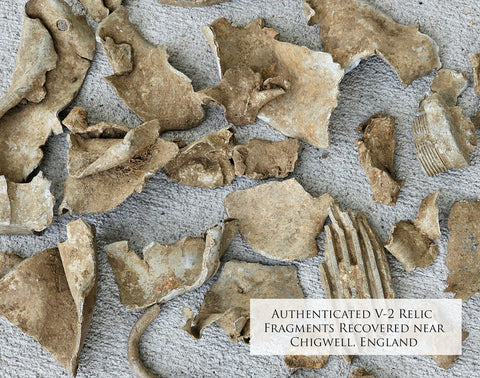This Fine Art Print by Artist Craig Tinder illustrates the power of the Germany's famed V-2 Rocket.
Details About the RELIC Plaque:
 V-2 rocket fragments - launched on 2 March 1945
V-2 rocket fragments - launched on 2 March 1945
This relic on display comes from the remains of a V-2 rocket, recovered near Chigwell, UK, just three miles from the London/Essex border. Between 1944 and 1945, a total of 13 V-2 rockets impacted Chigwell, with two striking on the same day—March 2, 1945. These attacks were part of Nazi Germany's relentless campaign against Britain during the final stages of World War II.
After researching the location where these fragments were excavated coupled with eye witness accounts which sets the date of the attack, we were able to unarchive the German records of that day and pieced together the pertinent details about the exact launch. Here's the story -
2 March 1945, 20 German soldiers and engineers of the Artillery Regiment 1./902 assembled at the Hoek van Holland V-2 Missle launch site in Holland to prepare 22 V-2 launches against London that day. Freshly supplied from the local railway, the 22,000 lb. rocket was filled with liquid propellant (ethanol & oxygen) and was prepared for launch. At precisely 5:35 am, the launch control officer yelled the final command, "Hauptstufe!" and the rocket roared into the air.
A mere 296 seconds later (at 3,500 mph or Mach 2.35), the rocket descended and exploded in an open field 3 miles northeast of London near Chigwell. Upon impact, a small house just 700 meters away was damaged. Just 7 minutes later, a second V-2 exploded, this time in the air, only 300 meters from the previous impact.
This original V-2 fragment was recovered from this area near Chigwell. It is unknown which of those two rockets this artifact originated from.
The V-2 rocket, officially known as the "Vergeltungswaffe 2" (Vengeance Weapon 2), was the world’s first long-range guided ballistic missile. It represented a significant leap in military technology, using liquid-fueled engines to propel it to heights of over 50 miles and speeds of more than 3,500 miles per hour. This made the V-2 nearly impossible to intercept, giving it the ability to rain destruction without warning. Upon re-entry into the atmosphere, the rocket would dive at supersonic speeds toward its target, detonating with a force of nearly 1 ton of explosives.
 V-2 Rocket - National AIr and Space Museum
V-2 Rocket - National AIr and Space Museum
The Story Behind the Print:
2 March 1945, at the Hoek van Holland V-2 Missile launch site, 20 members of the German Artillery Regiment 1./902 meticulously readied 22 V-2 rockets for an extensive assault on London. Replenished by recent rail deliveries, they armed a 22,000-pound rocket with its ethanol and oxygen propellants in preparation for that day's mission.
The launch was initiated at exactly 5:35 am with a sharp call of "Hauptstufe!" from the launch control officer, propelling the rocket skyward toward England.
After a rapid 296-second flight, the rocket descended, detonating violently in a field near Chigwell, 3 miles from London, damaging a nearby house 700 meters from the crash site. Within 7 minutes, a second V-2 suffered a mid-air explosion only 300 meters from the first impact.
 Chigwell, UK Survey
Chigwell, UK Survey
About the V-2:
Germany's V-2 rocket was unleashed in 1944 and was the first man-made object to reach suborbital flight. The V-2 (technically known as the Aggregat 4) reached speeds of over five times the speed of sound and struck fear into the hearts of the Allied forces.
Due to their unprecedented speed and advanced guidance systems, Allied forces struggled to intercept or defend against them effectively. With over 3,000 V2s launched at Allied targets, their ballistic trajectory and unpredictability posed a tremendous challenge for anti-aircraft defenses.
The development and deployment of the V-2 rocket represented a turning point in the history of warfare and rocketry, laying the groundwork for future space exploration endeavors.
Germany's V-2 rocket was unleashed in 1944 and was the first man-made object to reach suborbital flight. Traveling at over 5 times the speed of sound, over 3,000 V-2s were unleashed against Allied targets in England and Belgium. Given their incredible speed and silent delivery, none of the V-2s were ever intercepted.
Learn more about Doodlebugs and V-2 Rockets in the Intriguing Disparity? Click Here
To purchase the V-2 Relic Plaque or see similar items, visit here.
Commissioned by Museums, Treasured by Collectors





Share:
What were Spitfires used for?
Why Russia copied the B-29?